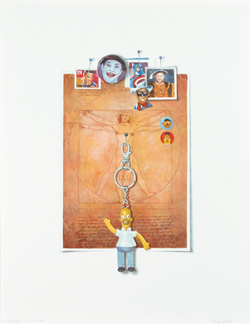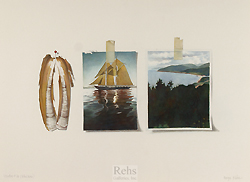BIOGRAPHY - Margie Kuhn (Born 1952)
A Kansas native, Margie Kuhn bases her art on her experiences in and ideas about the Midwest. Kuhn grew up in Lawrence, Kansas and attended Kansas University and the University of Puget Sound in Tacoma, Washington. She earned an undergraduate degree in scientific illustration and worked as a freelance scientific illustrator for a few years before she began teaching art at a local art center. Kuhn taught children and adults for more than 10 years, and this experience inspired a return to school, where she earned a Masters of Art Museum Education and later a Masters of Fine Arts in painting. Kuhn currently teaches Color Theory and Basic Design in the Design Department at the University of Kansas. Previously, she was the Education Coordinator at the Mulvane Art Museum in Topeka, Kansas; she also taught in the art department at Baker University in Baldwin, Kansas and at Washburn University in Topeka, Kansas.
Originally, Kuhn worked in watercolors and acrylics, using her teaching experience with small children to develop a long series of paintings/collages that explored ideas of representation and how we see and draw. After her return to school in the 1990s, her studies and consequent experiences as a museum educator lead her to develop a large installation—Evidence of Human Occupation—that looked at contemporary material culture in a museum-like setting. Kuhn developed wall text, labels, and books that elaborated on the construction, function, and ideology of the individual artifacts. In this body of work Kuhn looked at how society--particularly museums--determine value through what is collected and how it is presented. After documenting artifacts for a number of years, she began focusing on vegetation--in juxtaposition with art historical images, photographs, postcards, and found objects—to look at ideas about beauty, value, and the evolution of ideas. Kuhn’s current work depicts the object like a real thing, much like trompe l’oeil, to examine the object’s meaning in its own right, its relationship to other objects/artifacts, and how the meaning changes through context and time.
Of particular interest is the changing status of cultural standards and how society represents itself through its material culture. Kuhn’s paintings often critique the loss of culture or evolution of concepts, particularly beauty, gender/feminism, or the sublime. One series of work looks at changing notions of the sublime as it is portrayed in late 19th Century American landscape paintings compared to contemporary ideas about the exalted and majestic, such as Superman or chocolate in modern society. Another looks at the proportions of man and the representation of women in art and culture, a result of analysis of her extensive Happy Meal toy collection.
In the past few years, Kuhn’s work has been exhibited in Illinois, Colorado, Kansas, Missouri, and Kentucky. She is associated with a group of national artists that explore material culture in the series of changing exhibitions-- “Extraordinary Things: A Study of Contemporary Art Through Material Culture”-- which has been shown in Connecticut and Indiana. Kuhn’s drawings and paintings have also been displayed at the Nelson-Atkins Museum of Art, Wichita Art Museum, Salina Art Center, Springfield Art Museum, and the National Academy Galleries in New York. She was the featured artist in the journal, Cottonwood Review, 1999. Kuhn is the recipient of a Kansas Arts Development Grant, a Kansas Artist-in-Education Residency, and numerous grants and scholarships through the University of Kansas. She has given presentations on aesthetics, art criticism, and installation art to several universities, as well as the Kansas Art Education Association and the National Art Education Association. Kuhn lives in Lawrence, Kansas where she shares a studio with her husband John Kuhn, a photorealist painter, and their cat Sally, a very helpful Cornish Rex.


